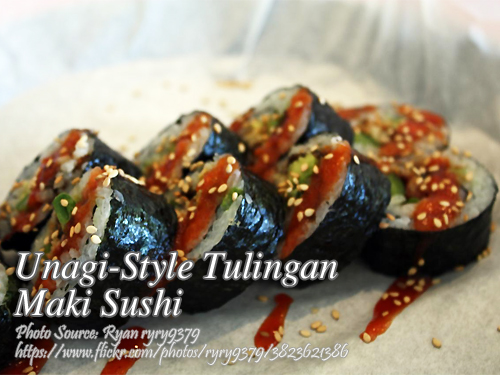This tulingan maki sushi recipe is a Pinoy version of the Unagi Sushi. Unagi is a Japanese word for freshwater eel. The kind of freshwater eel used in their cuisine is a Japanese eel (Anguilla japonica) and those species are also found in other countries like China, Korea, Vietnam and northern part of the Philippines. Since eel is not popular here, substituting it with tulingan or skipjack tuna is a good idea. So if you want to try making an unagi sushi, I think this tulingan sushi is a very good way of trying it.
Unagi-Style Tulingan Maki Sushi
Back when I was in college in Cebu, my dorm mate Yuki (yes, her name really was Yuki—her mom was half-Japanese!) once brought back a neatly packed tray of what looked like sushi from their short trip to Tokyo. It was my first time tasting unagi—sweet, savory, and just slightly smoky, it was unlike anything I’d ever eaten growing up in Batangas where grilled fish meant inihaw na tilapia or tulingan sa gata. I remember thinking, “This could taste even better with something more local.”
Fast forward years later, and it was my Tito Nonoy—yes, the same Tito who fries daing with so much garlic the neighbors start craving—who gave me the idea. He said, “Try mo kaya gawin sa tulingan yan. Para at least, swak sa panlasa pero sosyal pa rin!” That idea stuck.
And that’s how this Filipino-style sushi roll was born. Tulingan maki sushi is a humble yet flavorful nod to Japanese unagi maki, but uses a fish we know and love—skipjack tuna. Whether you’re new to sushi making or simply want to explore a local take, this dish offers the best of both worlds.
What is Tulingan Maki Sushi?
In traditional Japanese cuisine, unagi refers to freshwater eel, specifically the Anguilla japonica species. It’s a prized delicacy, often served grilled and glazed with a sticky-sweet sauce. But eel isn’t exactly common in most Pinoy palengkes—and when you do find one, your wallet might cry.
That’s why tulingan, or skipjack tuna, is a brilliant substitute. It’s affordable, widely available in coastal provinces, and its meaty, oily texture makes it a great stand-in for eel. Especially when fried and glazed with a homemade teriyaki sauce, it transforms into something just as indulgent.
I’ve served this several times during handaans and even at a potluck once at Ate Cely’s house in Quezon City. No one guessed it wasn’t real unagi until I told them!
Why Frying Works Best for Tulingan Sushi
You might be wondering why we fry the tulingan first instead of steaming or grilling it. Trust me, I tried them all. But frying gives it a slightly crispy edge and keeps the flesh intact when it’s time to roll. Plus, it holds up beautifully when soaked in teriyaki sauce—absorbing just enough flavor without falling apart.
And speaking of the sauce, don’t skip it. That glossy, sweet-salty glaze is what gives this roll its identity. Think of it as the final brushstroke on a painting.
How to Roll the Perfect Tulingan Maki Sushi
Rolling sushi may seem intimidating, but don’t worry—I didn’t have a bamboo mat the first time I tried this either. I actually used a clean plastic wrap, the same kind I used to wrap my baon back in high school. Just lay the cling wrap over a chopping board, then layer your nori, rice, and fish. Gently roll it using the wrap to help shape it, and don’t forget to wet your knife before slicing—sobrang helpful nito to keep the rice from sticking.
The key to good sushi rice is balance. After cooking, season it with a mix of mirin and sugar. A bit of salt and pepper rounds everything out. It’s this subtly seasoned rice that binds everything together in one cohesive bite.
Tulingan Sushi and Its Surprising Roots
You may not know this, but Japanese eels—those used in authentic unagi—are actually found in northern Luzon, particularly in Cagayan. Locals have known about them for generations, though they’re rarely used in everyday cooking due to their rarity.
So in a way, this recipe feels like a bridge between two cultures. A Filipino fish with Japanese technique. A humble pantry item transformed into something worthy of celebration. Isn’t it amazing how food tells stories without words?
Serving and Sharing Your Tulingan Maki
This dish is best served fresh, with soy sauce and a little wasabi if you like a kick. But honestly? Even without the frills, the glaze and fried fish combo sings on its own. My Kuya Emil likes to dip his in calamansi-soy sauce instead, swearing it adds a local twist. Try both and see which one wins your heart.
If you’re feeling a bit fancy, you can sprinkle sesame seeds on top or drizzle a little extra sauce before serving. Perfect for date nights at home, sushi-themed salu-salo, or just to impress your Tita who swears you can’t cook.
Whether you’re a sushi first-timer or just want to experiment with something close to home, this tulingan maki sushi is a beautiful blend of tradition and innovation. It’s a dish I’ll keep making, not just for its flavor, but for the stories that come with every roll.
Have you tried making sushi with local fish before? Let me know in the comments—I’d love to hear your stories, too!
How to Cook Unagi-Style Tulingan Maki Sushi
Ingredients
- 200 grams Tulingan skipjack tuna, fried
- 2 sheets Nori
For the Sushi Rice:
- 200 grams cooked Jasmine rice keep warm
- 2 Tbsp Mirin Japanese cooking rice wine
- 1 1/2 Tbsp. sugar
- salt and pepper to taste
For the Teriyaki Sauce:
- 2 Tbsp. soy sauce
- 2 Tbsp. water
- 1 Tbsp. tomato ketchup
- 1 Tbsp. honey
Slurry:
- 1/2 Tbsp. cornstarch
- 1/2 cup water
Instructions
How to make Unagi-Style Tulingan Maki Sushi:
- After frying the tulingan (skipjack tuna), remove the whole fillet from the bones, then cut it in half lengthwise. Set aside.
- Make teriyaki sauce by combining all the ingredients listen above and let it simmer for about 2 minutes. Add the slurry and let it simmer for around 1 minute to thicken.
- Place the fried tulingan fillet in the teriyaki sauce, marinate for 15 minutes.
- Combine the mirin and sugar in the newly cooked rice. Mix well, then season to taste with salt and pepper. Cover it with cling wrap and set aside.
- If you don't have a sushi rolling mat, you can use a cling wrap instead. Place a sheet of cling wrap over your chopping board.
- The wrap should be bigger than your nori sheet, rough side up, then place a a sheet of nori on the cling wrap and place a thin layer of rice over the nori, leaving 1 inch space from the top.
- Place the sliced marinated tulingan fillet over the rice, then roll it using the cling wrap to help you roll it perfectly.
- Take out the plastic wrap and cut it into 8, using a wet knife every slice to prevent the rice from sticking to the knife.
- Serve with soy sauce and wasabi.
Notes
Cooking Tips:
Use Fried Tulingan for Better Texture and Flavor
Frying the tulingan fillet before marinating gives it a firmer, meatier bite that holds up well when rolled into sushi. It also creates a slightly crispy edge that soaks up the teriyaki glaze beautifully, giving every bite a savory-sweet balance. Unlike steaming or boiling, frying intensifies the natural umami of the fish and prevents it from falling apart when slicing.Wet Your Knife for Cleaner Sushi Cuts
Slicing sushi can get messy if rice sticks to your knife, ruining the roll’s presentation. To avoid this, dip your knife in cold water and wipe it clean between each cut. This simple trick gives you sharp, smooth slices that look as good as they taste.Season Sushi Rice While It's Still Warm
Sushi rice absorbs flavors best when it’s freshly cooked and still warm. Mixing in the mirin, sugar, and salt while the grains are hot ensures an even, well-balanced flavor throughout. Let it cool slightly under cling wrap to keep it moist and sticky enough for rolling.





